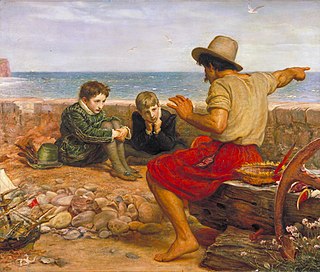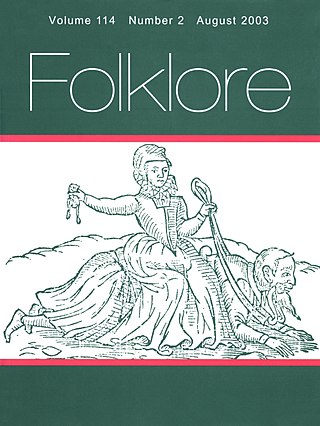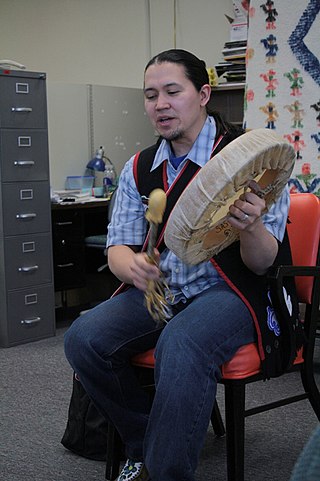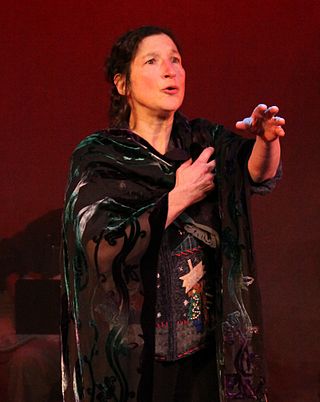
Folklore is the body of expressive culture shared by a particular group of people, culture or subculture. This includes oral traditions such as tales, myths, legends, proverbs, poems, jokes, and other oral traditions. This also includes material culture, such as traditional building styles common to the group. Folklore also encompasses customary lore, taking actions for folk beliefs, and the forms and rituals of celebrations such as Christmas, weddings, folk dances, and initiation rites.

A joke is a display of humour in which words are used within a specific and well-defined narrative structure to make people laugh and is usually not meant to be interpreted literally. It usually takes the form of a story, often with dialogue, and ends in a punch line, whereby the humorous element of the story is revealed; this can be done using a pun or other type of word play, irony or sarcasm, logical incompatibility, hyperbole, or other means. Linguist Robert Hetzron offers the definition:
A joke is a short humorous piece of oral literature in which the funniness culminates in the final sentence, called the punchline… In fact, the main condition is that the tension should reach its highest level at the very end. No continuation relieving the tension should be added. As for its being "oral," it is true that jokes may appear printed, but when further transferred, there is no obligation to reproduce the text verbatim, as in the case of poetry.

A first-person narrative is a mode of storytelling in which a storyteller recounts events from that storyteller's own personal point of view, using first-person grammar such as "I", "me", "my", and "myself". It must be narrated by a first-person character, such as a protagonist, re-teller, witness, or peripheral character. Alternatively, in a visual storytelling medium, the first-person perspective is a graphical perspective rendered through a character's visual field, so the camera is "seeing" out of a character's eyes.

Storytelling is the social and cultural activity of sharing stories, sometimes with improvisation, theatrics or embellishment. Every culture has its own narratives, which are shared as a means of entertainment, education, cultural preservation or instilling moral values. Crucial elements of stories and storytelling include plot, characters and narrative point of view. The term "storytelling" can refer specifically to oral storytelling but also broadly to techniques used in other media to unfold or disclose the narrative of a story.

A narrative, story, or tale is any account of a series of related events or experiences, whether non-fictional or fictional. Narratives can be presented through a sequence of written or spoken words, through still or moving images, or through any combination of these. The word derives from the Latin verb narrare, which is derived from the adjective gnarus. The formal and literary process of constructing a narrative—narration—is one of the four traditional rhetorical modes of discourse, along with argumentation, description, and exposition. This is a somewhat distinct usage from narration in the narrower sense of a commentary used to convey a story. Many additional narrative techniques, particularly literary ones, are used to build and enhance any given story.
William Labov is an American linguist widely regarded as the founder of the discipline of variationist sociolinguistics. He has been described as "an enormously original and influential figure who has created much of the methodology" of sociolinguistics.
Diegesis is a style of fiction storytelling in which a participating narrator offers an on-site, often interior, view of the scene to the reader, viewer, or listener by subjectively describing the actions and, in some cases, thoughts, of one or more characters. Diegetic events are those experienced by both the characters within a piece and the audience, while non-diegetic elements of a story make up the "fourth wall" separating the characters from the audience. Diegesis in music describes a character's ability to hear the music presented for the audience, in the context of musical theatre or film scoring.
Narration is the use of a written or spoken commentary to convey a story to an audience. Narration is conveyed by a narrator: a specific person, or unspecified literary voice, developed by the creator of the story to deliver information to the audience, particularly about the plot: the series of events. Narration is a required element of all written stories, presenting the story in its entirety. It is optional in most other storytelling formats, such as films, plays, television shows and video games, in which the story can be conveyed through other means, like dialogue between characters or visual action.

Folklore studies is the branch of anthropology devoted to the study of folklore. This term, along with its synonyms, gained currency in the 1950s to distinguish the academic study of traditional culture from the folklore artifacts themselves. It became established as a field across both Europe and North America, coordinating with Volkskunde (German), folkeminner (Norwegian), and folkminnen (Swedish), among others.

Autoethnography is a form of ethnographic research in which a researcher connects personal experiences to wider cultural, political, and social meanings and understandings. It is considered a form of qualitative and/or arts-based research.

Narrative inquiry or narrative analysis emerged as a discipline from within the broader field of qualitative research in the early 20th century, as evidence exists that this method was used in psychology and sociology. Narrative inquiry uses field texts, such as stories, autobiography, journals, field notes, letters, conversations, interviews, family stories, photos, and life experience, as the units of analysis to research and understand the way people create meaning in their lives as narratives.
Show, don't tell is a narrative technique used in various kinds of texts to allow the reader to experience the story through actions, words, subtext, thoughts, senses, and feelings rather than through the author's exposition, summarization, and description. It avoids adjectives describing the author's analysis and instead describes the scene in such a way that readers can draw their own conclusions. The technique applies equally to nonfiction and all forms of fiction, literature including haiku and Imagist poetry in particular, speech, movie making, and playwriting.
Transmedia storytelling is the technique of telling a single story or story experience across multiple platforms and formats using current digital technologies.

Oral storytelling is an ancient and intimate tradition between the storyteller and their audience. The storyteller and the listeners are physically close, often seated together in a circular fashion. The intimacy and connection are deepened by the flexibility of oral storytelling which allows the tale to be molded according to the needs of the audience and the location or environment of the telling. Listeners also experience the urgency of a creative process taking place in their presence and they experience the empowerment of being a part of that creative process. Storytelling creates a personal bond with the teller and the audience.
American Sign Language literature is one of the most important shared cultural experiences in the American deaf community. Literary genres initially developed in residential Deaf institutes, such as American School for the Deaf in Hartford, Connecticut, which is where American Sign Language developed as a language in the early 19th century. There are many genres of ASL literature, such as narratives of personal experience, poetry, cinematographic stories, folktales, translated works, original fiction and stories with handshape constraints. Authors of ASL literature use their body as the text of their work, which is visually read and comprehended by their audience viewers. In the early development of ASL literary genres, the works were generally not analyzed as written texts are, but the increased dissemination of ASL literature on video has led to greater analysis of these genres.

Alaska Native storytelling has been passed down through generations by means of oral presentation. The stories tell life lessons or serve as lessons in heritage. Many different aspects of Arctic life are incorporated into each story, mainly the various animals found in Alaska. Due to the decline in the number of speakers of native languages in Alaska and a change in lifestyle amongst many of the native peoples, oral storytelling has become less common. In recent years many of these stories have been written down, though many people argue that the telling of the story is just as important as the words within.

Judith Black is an American professional storyteller, who has toured internationally, telling stories to a wide ranging audience in the United States, Europe, and the Near East. She has produced thirteen CDs, and won a variety of awards, such as the coveted Oracle Award. Her work has been featured in venues such as the Smithsonian Institution and the Montreal Comedy Festival, and has been featured seven times at the National Storytelling Festival. In addition she has produced a variety of seminars and workshops for storytellers. She has been commissioned by the U.S. Department of the Interior, National Public Radio, religious institutions, and non-profit organisations to create original stories that strengthen their respective missions.
The theory of narrative identity postulates that individuals form an identity by integrating their life experiences into an internalized, evolving story of the self that provides the individual with a sense of unity and purpose in life. This life narrative integrates one's reconstructed past, perceived present, and imagined future. Furthermore, this narrative is a story – it has characters, episodes, imagery, a setting, plots, and themes and often follows the traditional model of a story, having a beginning, middle, and an end (denouement). Narrative identity is the focus of interdisciplinary research, with deep roots in psychology.
In linguistics, psychology, and literary theory, the concepts of deictic field and deictic shift are sometimes deployed in the study of narrative media. These terms provide a theoretical framework for helping literary analysts to conceptualize the ways in which readers redirect their attention away from their immediate surroundings as they become immersed in the reality generated by the text.
Tellability is quality for which a story is told and examined as remarkable with its constructed merit. Ochs and Capps examine tellability as the reason a narrative is told. Namely speakers can transform any instance into a meaningful narrative, but most are tellable due to how they deviate from everyday happenings and the prototypical. A narrative changes dependent on its level of tellability, and these elements are largely contextual. The tellability of a story often parallels the perceived truth of the story.









